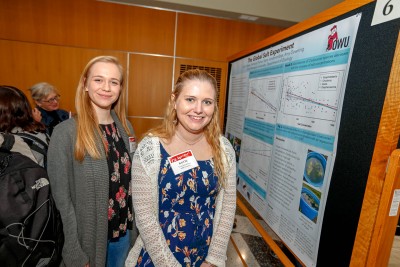Abstract
The Global Salt Experiment
 Students: Rebecca Porter, Katie Vonderembse, and Colin Hawes
Students: Rebecca Porter, Katie Vonderembse, and Colin Hawes
Faculty Mentor: Amy Downing (OWU Department of Zoology)
The United States spreads approximately 10 million tons of road de-icing salt per year to keep roads safe. However, when this salt is washed away, it can enter bodies of water where it can potentially harm animals and water quality. We are examining the effect of salt concentration on the abundance and variety of certain microscopic organisms by replicating the conditions of a local pond in a small, controlled environment. Evidence that road salt can have toxic effects on these animals may encourage the use of a more environmentally friendly alternative to salt.
Runoff from human activities can have harmful effects on freshwater ecosystems. Road salt and agricultural pollutants can enter bodies of water, potentially disrupting their stability. To explore the effects of salt and nutrient runoff on freshwater ecosystems, we participated in a 20 site study across the northern USA, Canada, and Europe. In this study, we exposed communities of zooplankton to concentrations of sodium chloride (NaCl) ranging from 5 to 1,500 mg Cl-/L. The experiment consisted of fifty-three 325 liter mesocosms located adjacent to the lower pond at Ohio Wesleyan University’s Kraus Nature Preserve in Delaware, OH. Each mesocosm was filled with the adjacent pond water and its natural microbial, phytoplankton, and zooplankton communities, excluding large macroinvertebrates and fish. All tanks were treated with a gradient of NaCl. In 21 of the tanks, we added 50% more nutrients than in the natural pond to examine how the systems would react to NaCl with additional nitrogen and phosphorus, common nutrients in agricultural runoff. Over 6 weeks, we took bi-weekly samples from the mesocosms for zooplankton and phytoplankton (algae) abundance data and collected water chemistry and quality parameters. Preliminary data analysis suggests that high salt concentrations are toxic for all species of zooplankton. Of the three main groups of zooplankton found, rotifers had the highest tolerance, followed by copepods. Cladocerans, such as Daphnia and Scapholeberis, had the lowest tolerance. Our data indicate that tanks with additional nutrients had higher abundances of zooplankton up to a certain threshold (~1,000 mg Cl-/L), due to an increase in algae, the main food source for zooplankton. As zooplankton decreased at high concentrations of salt, algae increased, which is characteristic of unhealthy freshwater ecosystems. These findings suggest that if the use of road salt continues, changes should be implemented in order to conserve freshwater ecosystems.
